So, You Think You Want To Grow Avocados...
If you live in USDA Zone 9, you just might be able to grow a productive avocado tree...maybe.
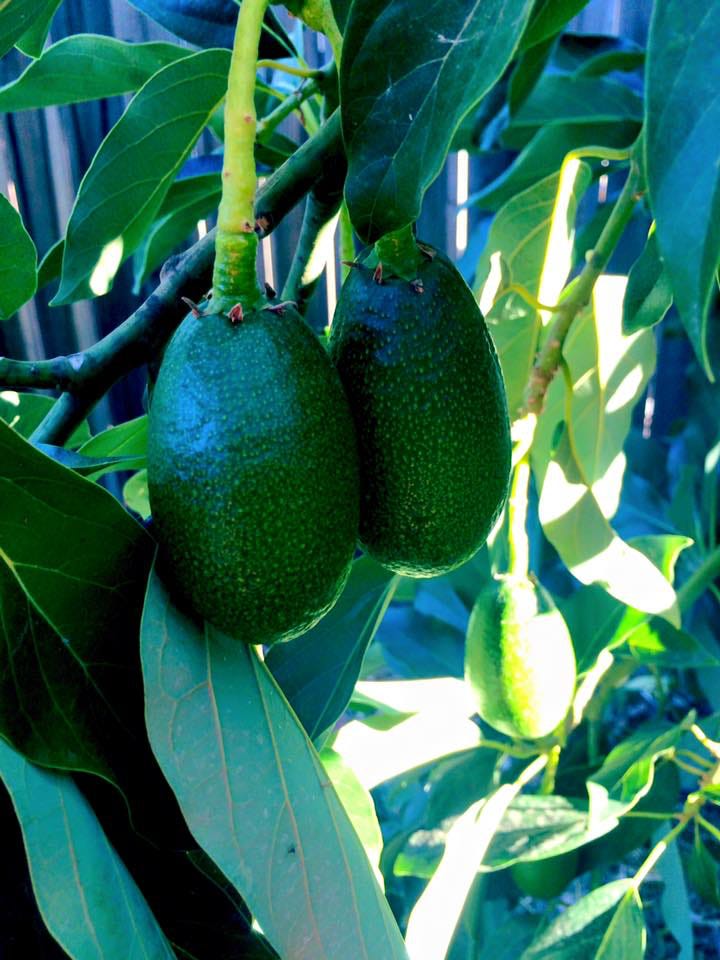
On Episode 140 of the Garden Basics with Farmer Fred podcast, we feature our favorite retired college horticulture professor, the aptly named Debbie Flower. She offers some outstanding tips for becoming a better observational gardener (noticing plant situations before they become big problems); how to deal with a backyard full of giant pumpkins; and, growing avocado trees in marginal climates. More on that last one in a minute.
But first, I must confess, I am in love with Debbie Flower’s brain. Every time I listen to what she has to say, I learn something new, something I didn’t pick up the last time I listened. For that reason, she is one of my horticultural heroes (which is a very short list).
I listen to each episode at least three times: while it is being recorded, while I’m editing it, and when I do the transcription for the episode. And whenever Debbie is on, I hear her say something that is very insightful for gardeners, something I didn’t hear on listen #1 or #2. Definitely, if you want to learn more about gardening, listen to her segments repeatedly. You will learn something new, each time. We are very lucky to have her on the show on a regular basis.
On the question and answer segment of Episode 140, we tackled a question from Doug in Auburn, CA. He wants to grow avocado trees, because he and his wife are hooked on avocados (a condition for which there is no known intervention group). Auburn is located in the Sierra Nevada foothills, in Placer County, northeast of Sacramento. Frankly, it is a commuter suburb for Sacramento, but attracts many homeowners willing to put up with a 35-60 minute commute to Downtown Sac because of its foothill charms. The Chamber of Commerce uses that “35 minute” number, which is true…at 2 a.m. People who drive it every morning and afternoon would put it at 60+ minutes.
Despite its foothill location (elevation: 1200-1500 feet), Auburn’s climate is very similar to Sacramento (elevation: 30 feet). And growing a productive avocado tree in Sacramento is a challenge: daytime temperatures in the spring and summer easily reach 100 degrees, winter nighttime lows dipping down into the 30’s (and lower), low humidities and afternoon winds. Avocado trees need a special location to insure the survival of the plant’s flowers to bear fruit.
Avocados are grown commercially in California in the state’s “Garden of Eden” zones: coastal valleys of southern and central California where temperatures seldom get above 90 in the summer and stay in the 40’s and 50’s during winter nights.
However, University of California researchers are working on developing avocado varieties that can be grown commercially in California’s Central Valley, one of the most fertile farming areas in the world, a combination of two adjacent valleys, the San Joaquin and the Sacramento, that stretches for hundreds of miles south to north, from Bakersfield to Redding, protected by the Coast Range mountains on the West and the Sierra Nevada and Cascade mountains to the east.
And if commercial avocados take hold in the Central Valley, that means that home gardeners in USDA Zone 9 (and maybe Zone 8?) can have more success growing backyard avocado trees.
What about growing avocado trees indoors, anywhere? The California Avocado Commission says, yes, you can grow an avocado tree indoors* (* “Please note that the odds that your tree will bear fruit are very small”).
So, there’s that. But if you are in USDA Zone 9, and want to try growing a productive avocado tree outdoors…here are some guidelines. And good luck.
From the garden email bag, Nelson wants to know:
"Hi Fred, I wanted to ask you a question because none of my friends seem to know. I live in Elk Grove (southern Sacramento County) and have an avocado tree that I planted early this spring. Its grown about a good 8-12 inches in the past few months and has been doing well. In October, I started noticing the leaves begin to brown. The tree sees about 4 hours of sunlight a day due to the location of the tree and surrounding shade trees and home. Any suggestions on what this browning and how to take care of it would be great!"
Watering may be the culprit. Avocados need moisture, but they need excellent drainage. If the soil is too moist for too long, that can cause leaf drop due to any number of soil borne diseases such as verticillium wilt or root rot (phytophthora). Check the moisture level around the root zone at the outer edges of the tree, about 10 inches down, before you water. A moisture meter can aid you in this. Planting on mounds can alleviate the problem of poor drainage, as well.
Good water management is essential to reduce the threat of rot. It prolongs the life of diseased trees and can prevent spread to other trees. Moreover, the only way to know how much water is correct for your soil is using that moisture meter or digging down to the root zone and grabbing a handful of the soil. If that handful is muddy, don’t add more water yet. If that soil is bone dry, then definitely increase your watering frequency. The ideal moisture level for that handful of soil: you should be able to form a clod easily with your hand, yet break it apart easily. There should not be water running down your arm.
For those interested in trying to grow avocados here, choose varieties that have a chance to survive our cold winters.
Among the avocado varieties that may succeed here are the Bacon, Zutano, Mexicola, Fuerte, Pinkerton, Jim, Sir Prize and Stewart. These have better cold tolerance; however, success here with avocados is iffy. Placing the tree where it can get reflected heat in the winter from a south-facing wall may help.
What about the Hass Avocado?
That tasty grocery store staple prefers to grow in the most mild areas of California, where frosts are very rare: San Diego and Ventura counties are prime Hass avocado growing regions. Try to grow a Hass here, and it will probably die. Probably. I used to never say "probably". Then, listener Gayle of Dixon (west of Sacramento) sent in this:
Yep, a producing Hass avocado tree, albeit a small one.
ALL GARDENING IS LOCAL (Farmer Fred Rule #1). Get back to me, Gayle, when that tree gets bigger than the house, and is still loaded with fruit.
More Avocado Advice for the Brave USDA Zone 9 Gardener
Another tip to get avocados to bear fruit: plant two different varieties. Avocado pollination is increased when you have two types of avocado trees, one with an "A" flower and one with a "B" flower. These flower types open at different times of the day. According to the California Rare Fruit Growers Association, avocado flowers are either receptive to pollen in the morning and shed pollen the following afternoon (Type A), or are receptive to pollen in the afternoon, and shed pollen the following morning (Type B). The latest edition of the Sunset Western Garden Book lists the “Type A” flower varieties to include the Mexicola and Pinkerton. The Bacon, Jim, Zutano, Fuerte, SirPrize, and Stewart are Type B flowers. Stewart, actually, may be both Type A and B, depending on where it is grown. These Mexican avocados mature 6-8 months after flowering.
The California Rare Fruit Growers advise avocado tree owners to: “use a balanced fertilizer, four times yearly. Older trees benefit from feeding with a nitrogen fertilizer, applied in late winter and early summer. Yellowed leaves (chlorosis) may indicate iron deficiency. A chelated foliar spray of trace elements containing iron can usually correct this. Mature trees often also show a zinc deficiency.”
More about the flowers, fruits and growing needs of several avocado varieties, from the Avocado Information website of the University of California Agricultural and Natural Resources:
The avocado flower has both functional male and female organs. The male floral organ, which produces pollen, is comprised of the anthers and stamens. The female floral organ is comprised of the stigma (which receives the pollen), style and the ovary. The avocado exhibits a type of flowering behavior known as "synchronous dichogamy". An individual flower will be open for 2 days, however the timing of the male and female phases are distinct. When the flower first opens it is in the female phase and the stigma is receptive to pollen. At the end of the female phase, which lasts 2 to 4 hours, the flower will close. On the second day the same flower re-opens in the male phase and sheds its pollen.
"A" Avocado Flower Varieties
Mexicola
Mexican varieties have an anise or fennel-like smell to the leaves.
This is a very typical Mexican variety. Originated about 1910 as a seedling at Coolidge Rare Plant Gardens, Pasadena, CA, Fruit season, Aug.-Oct.; color, black; weight, 3-5 ozs.; shape, spherical to pyriform; skin, thin, smooth; flavor, excellent. One of the first varieties to be commercial, planted by Mr. Henry Huntington around 1915-17. It has an anise flavor & is quite good tasting. Bears early & regularly; very heat & cold resistant (down to 20 degrees...maybe).
Pinkerton
Commercial variety. Harvest begins in January in some commercial areas.
High oil content. Medium slightly spreading tree. Hardy to 30 degrees.
"B" Avocado Flower Varieties
Bacon
Originated in Buena Park, California, by James Bacon. Introduced in 1951.
Flesh has an unusually pale yellow/green color. Oil content high. Matures Nov. to Jan. in Orange County and Dec. to Mar. in Ventura County, CA. Consistant,heavy producer; frost tolerance excellent. Bacon has a commercial background. Large trees.
Jim
Was commercial at one time.
Color when immature is a very light avocado green. Some fruit has a rosy blush that does not appear to be caused by thrips.
Zutano
Originated in Fallbrook, California, by W.L. Ruitt. Introduced in 1941 from a selection made in 1926.
Ripens in Oct. to Dec. in San Gabriel Valley, Ca.; and Jan. to Feb. in Ventura County, Ca. Tree; consistent producer; hardy to 24 degrees; more hardy than Fuerte. Commercial variety. Fruit are oval/pear in shape with waxy bumps on the skin.
Fuerte
Introduced as budwood in 1911 from Atlixco, Puebla, Mexico. A hybrid Mexican variety that is ready to pick in November and is good through March.
Hangs on the tree well. A long time California commercial variety valued for its winter season and its B blossom type. Skin thickness is medium thin. Seed size is medium large.
SirPrize
Season of maturity averages 6-8 weeks earlier than Hass. Mexican-race type avocados are typically more cold resistant than 'Hass' so this tree is being tried in inland valleys and other regions unsuitable for Hass. Early results do not indicate it is any more cold tolerant than Hass.
Fruit shape is pear with distinctive ridge along one side. Skin texture is not truly pebbled like 'Hass' but does have tiny islands of varying yellowish shades giving the illusion of 'Hass'-like pebbles. 'Sir Prize' is upright in tree form. Peak bloom period is earlier than 'Hass' by several weeks.
Stewart (A or B flower)
Originated in Mentone, San Bernardino County, CA, on the Stewart Ranch.
Introduced in 1956. Flesh clear, bright, light yellow shading to green toward skin, firm, but melting, excellent quality; ripens from early Oct. to mid-Dec. Tree: spreading, strong, vigorous; bears good crops. Although listed as an "A" type flower, it typically shows "B" flowering characteristics at South Coast Field Station in Irvine, CA.
Bottom Line
If you want to experiment, are willing to be patient, and have a wind-sheltered area with many surfaces of reflective heat, try the Mexicola and the Zutano varieties of avocado trees in USDA Zone 9, especially here in California’s interior. And good luck.
Pictures and variety information courtesy of the Avocado Information website of the University of California Agricultural and Natural Resources...
except for the pictures of Nelson's suffering avocado tree in Elk Grove and Gayle's magic Hass avocado tree in Dixon. Thank you for those!
Thanks for Subscribing, Sharing and Spreading the Word About the Garden Basics with Farmer Fred newsletter, I appreciate your support.
And thank you for listening to the Garden Basics with Farmer Fred podcast! It’s available wherever you get your podcasts. Please share it with your garden friends.
As an Amazon Associate, I earn from qualifying purchases from some of the underlined links in the newsletter. This is how I am trying to keep this a free newsletter. And as long as you buy whatever you want from Amazon using any of those links to get into the Amazon site, I get a few pennies. Thank you.




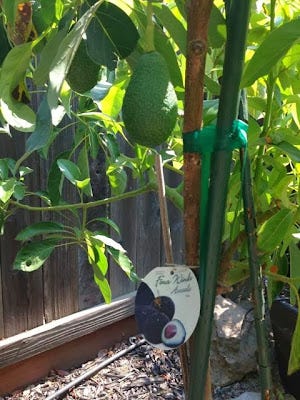
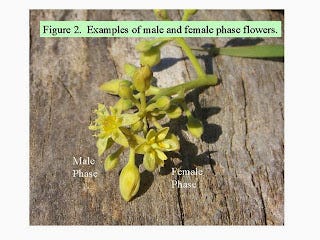


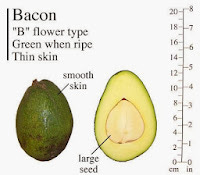
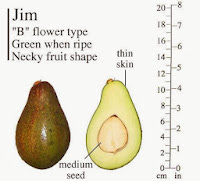
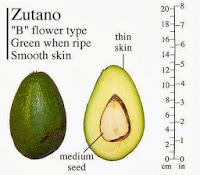
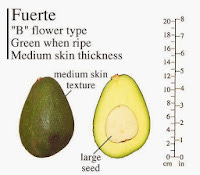

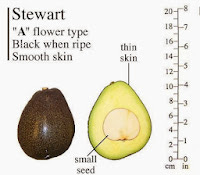
Yes avocados in South Carolina I have one about a foot high with about eight leaves on it and it's still in its pit sort of and in a bottle of water and it's thriving so well that I'm afraid to plant it and I don't know what to plant it in it's inside and it's in sort of a sunny area and this is the happy little thing and I'm a happy Mommy LOL